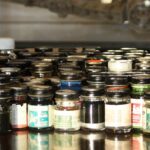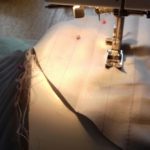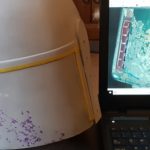Vintage Floquil is the trench warfare of found parts
Singleseat
You’ve been around for a while, you’re a member of The Dented Helmet and Boba Fett Builders, you’re on a few Facebook groups, and when someone says ‘MQ1’ you know what they mean without blinking. You may even be one of those people with four vintage Michell darts, your Paterson Squeegee has exactly the right patent marks, cutting up a Nemrod holster means nothing to you, your helmet and armour pieces are the best lineage copies [wherever possible], and the thought of a Hedstroem dental file that might be the right colour but isn’t the right number is your idea of blasphemy. You’re one of those guys, you are fully immersed, and your significant other displays a look of bemusement at your excitement whenever the latest piece of 70s junk arrives at great expense.
You’ve made it. You’re a fully-fledged Fett addict. You might not be Steven Coleman, Art Andrews, Keegan, RafalFett, or any of those guys, but you know enough to hold your own. You might even have your own special corner of arcane expertise; a little field that is all your own, and where no one knows more than you do.
There’s another sect though, and they’re strange. They’re those paint people, those Vintage Floquil people, and they’re obsessed with that Floquil Thing.
What happened to those guys, how did they get there, and what do they really know? Let’s try to find out.
That Floquil Thing
This piece is about Floquil paints within the scope of Boba Fett. It will cover some points on Floquil itself, some colours to be considered within the context of the Lee Malone/Rogue Studios list, and some of the research I have done. It’s not going to give you all the answers. It won’t even give you all the answers or knowledge that I have, or that I think that I have [after all, these colours are an ongoing discussion], but it should give you a flavour of the detail that goes into a hobby within a hobby.
Problems
Researching these paints is difficult for three main reasons. First, you’re not just researching one part; you’re researching a different part in respect of each colour – we’ll come back that. Second, you’ve got to actually acquire the stuff, which is more difficult than you might think; you’re looking at an investment of time that is not to be underestimated. Last, it’s an expensive pursuit – in terms of found parts that I have pursued in this hobby, it has been the single most costly aspect. The only saving grace, in that respect, is that the cost has been spread over many years because of the difficulty in acquisition, which was my second point.
When Singleseat wrote the above quote, which was probably over ten years ago, I had first thought that he was referencing the traditional fight for found parts that occurs whenever found parts become available – the bidding wars and high prices on the secondary and resale market. While that is true, to some degree, I don’t now think that is what he really meant. I think he was really talking about the endeavour itself, the long slog, every victory hard fought, and only after repeated failures.

A Brief Floquil History
Floquil was founded in 1940 by Harald Rosenlund as a Pen and Ink Company. Rosenlund’s first endeavour was a sort of early felt tip pen type dropper. The company built a plant in Cobleskill, NY during the second world war to produce paints for the US Navy. After the war the company moved into making paint for model enthusiasts, specifically for model railroads crowd. He approached various companies to ask for their ‘drift cards’, in order to ensure the best matches possible. By the time the 60s were ending, and the 70s beginning, Floquil was also producing several military colours, however; colour matching for military colours was more problematic because no colour swatch ‘drift cards’ were available before 1950.
By no later than 1974, Floquil had been acquired by Republic Powdered Metals, although they continued to produce both railroad and military colours, as well as acrylics in the Polly-S lines for both military and railroad modellers. Polly-S also later did fantasy colours.
Republic Powdered Metals, known today as RPM International, also acquired Testors and Pactra in 1984.
By the end of the 90s, the Floquil Military range had been discontinued along with the Marine Colours enamels and a slew of other products. By May 2013, the Floquil line was discontinued completely. RPM apparently chose to go with the perceived most recognisable brand, which was Testors. This included the Model Masters range, which was then discontinued in 2020.
A final point on this, I often read comments to the effect of ‘Testors discontinued Floquil’. That isn’t true. The company that owned both appears to have discontinued Floquil, as well as several other lines, in order to concentrate on what they felt was the strongest brand, i.e., Testors. But remember, the parent company has owned them all since the mid-70s.
Why Bother at All?
When I did my first helmet paintup, which was around 2011/12, I was working from a Terminal Fettler list as modified by Jayvee. This was a Humbrol based list, and it’s excellent by the way, but there was a concrete colour for the back panels that was expressed as a colour that Humbrol wasn’t giving me; it was Floquil concrete. While there are plenty of other concrete matches that have since been considered, at that time there didn’t seem to be an alternative. Because of that I made an ebay order for Floquil concrete. In fact, what I ended up buying, and used, was Pollyscale Aged Concrete, although that doesn’t really matter now. The point is that this was my first step into the Floquil world, and while Pollyscale Aged Concrete is a lovely colour, it certainly wasn’t the right colour.
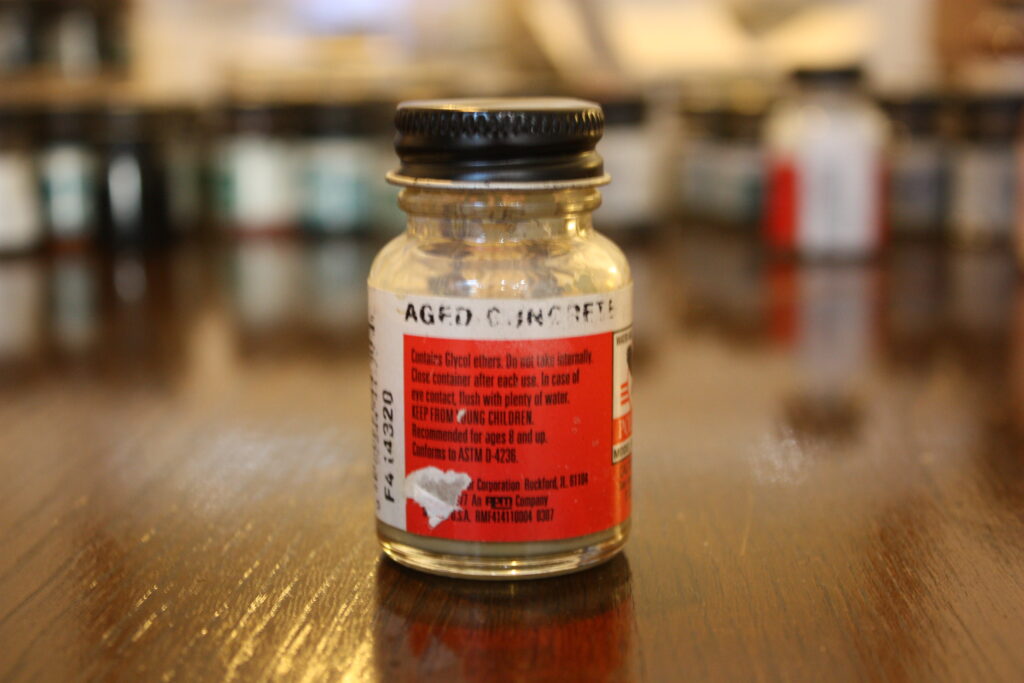
This brings me to the second strand of the issues in researching these old paints, which is acquisition.
I’m in the UK, and Floquil was never widely available here, because we had Humbrol. Why trouble to import paints from the US when there were plenty of paints still available? Humbrol are perfectly fine paints, except for the little tins that I dislike, but the evidence is pretty clear that these were not the colours used in the case of Fett – they may have been used for the ESB Rocket pack repaint to green, which is believed may have occurred in the UK, but there is ample evidence for Floquil paints in rest of the suit and helmets. So, that’s difficult, because I was trying to acquire a set of colours that were not really sold in my country, from a fairly small timeframe that was over forty years ago, and from a totally discontinued product. That’s a challenge, and an expensive one at that. Luckily, I had some friends to help along the way. While I was mostly able to do the legwork myself, every once in a while one of my pals would be called upon to help me acquire a piece of the puzzle. They know who they are.

Formula and Timeframe
Thankfully, we know when the Fett suits were made and painted, and to within a high degree of certainty. If you haven’t the time to trawl endless old forum posts and conduct your own research then consider yourself lucky, because Steven Coleman’s book, The Unofficial History of Boba Fett’s Costumes, has already done all the heavy lifting for you. For the purpose of this article, it is not necessary for me to steal Steven’s thunder by giving you the exact dates in his book because within the context of Floquil paints we only really need to know that it was late 70s, which I will explain below.
When it comes to Floquil railroad paints, there are four main naming conventions. These were, in chronological order: By name of colour alone e.g., ‘Light Green’, by double R prefix e.g., ‘RR41 Light Green’, by single R prefix e.g., ‘R41 Light Green’, and by Double 1 prefix e.g., ‘110041 Light Green’.
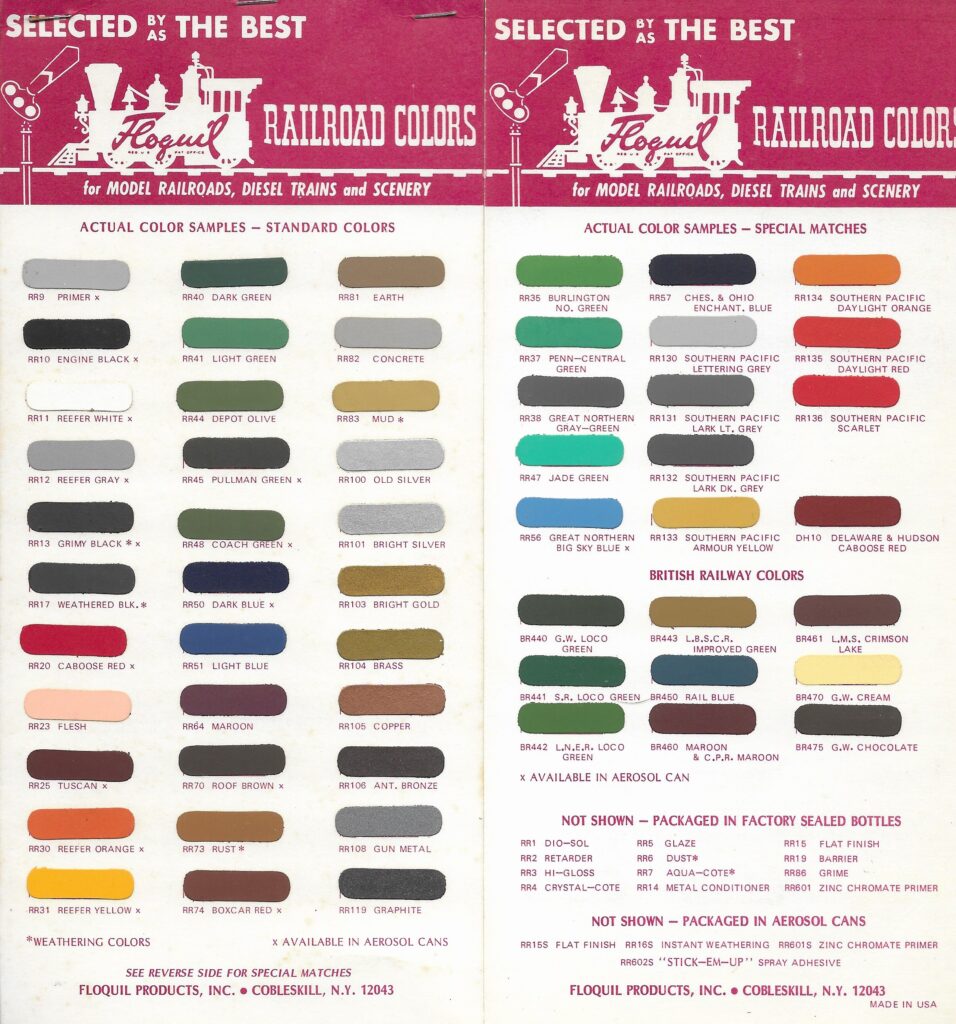
The earlier paints were all made using cellulose thinners such a Xylene or Toulene. These are nasty chemicals. The latter paints i.e., the 11s, were enamel based. If you’re not sure what type of paint you are holding then the smell will always give the older paints away. Obviously, you should not inhale these chemicals, but you won’t have to. The smell of cellulose thinners will be apparent as soon as the bottle opens. Make sure you are in a well-ventilated area.
We can comfortably discount the 11s as not being the correct period paints because they were not produced in our target window. Although I cannot give the exact date, I am confident that these were being produced no later than 1983, and although they may have been produced earlier than ‘83, I am confident that these were not introduced until the 1980s. That does not mean that they are no use entirely, because some of these later paints do maintain the correct colour, even after the formula change.
Conceivably, that still leaves anything produced before the late 70s as potentially having been used, which would include the older Floquil paints that were named by colour alone. Given that these can still just about be bought today, it would not make sense to discount them altogether, however; I think them less likely to have been still stocking the shelves in the target window.
The RR labelled paints were available no later than the mid-60s and were still being referred to by RR prefix up until 1978. The single R prefix is referenced in Floquil material as early as 1975 and is prominent by 1978. By 1979, the references to RR appear to stop altogether. I honestly cannot give a better indication than this. Floquil catalogues, lists, and other publications seem to be quite inconsistent on this point. I suspect that the actual product in hand and the changes to the published material were being used interchangeably during the target window, which is incredibly frustrating.
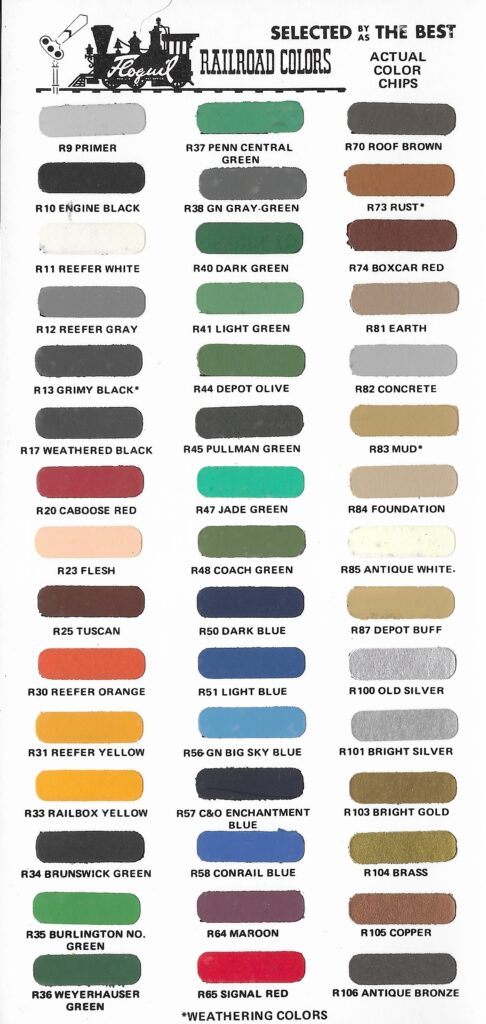
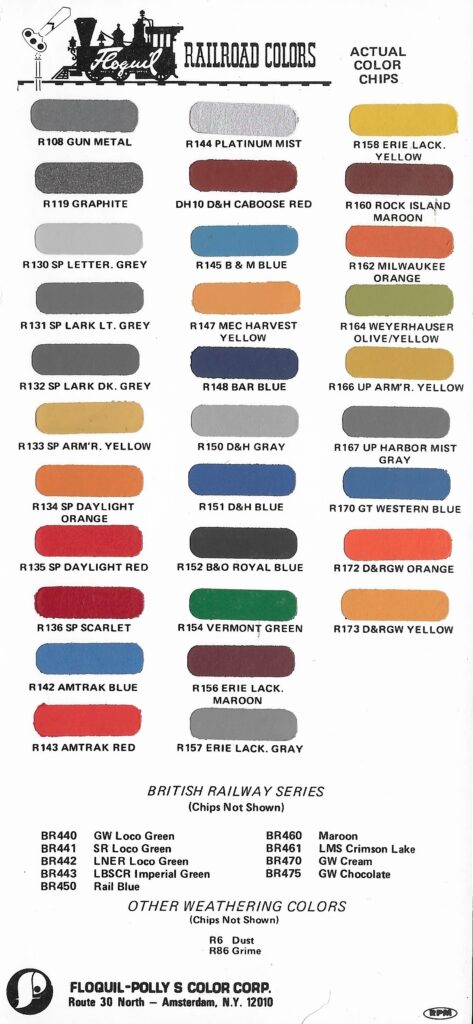
The two sets of chips above are part of a tri fold colour chart from 1979. The centre section contains references for some of the glaze and thinner materials. Additionally, there is a tri fold military sheet for the same period.
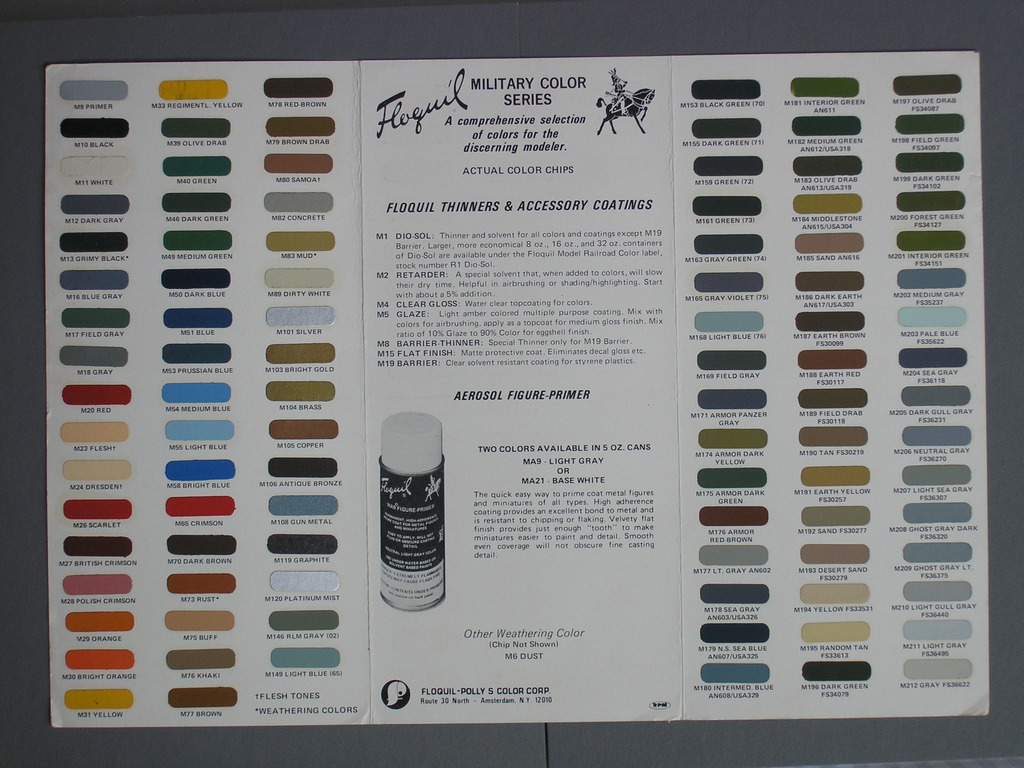
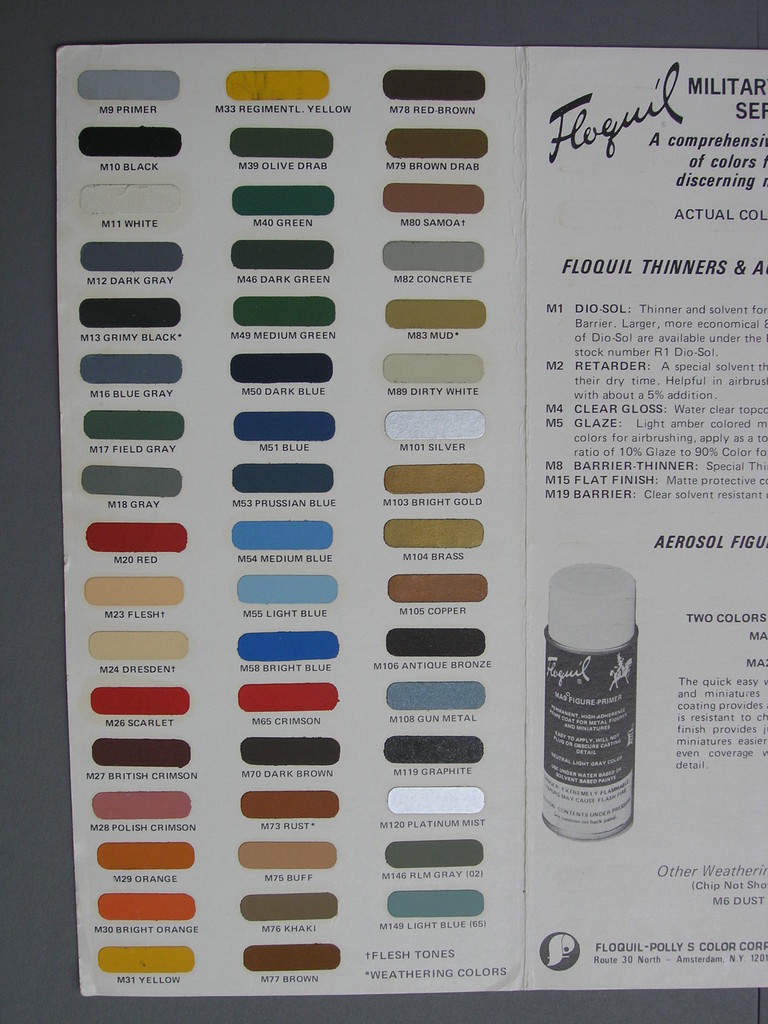
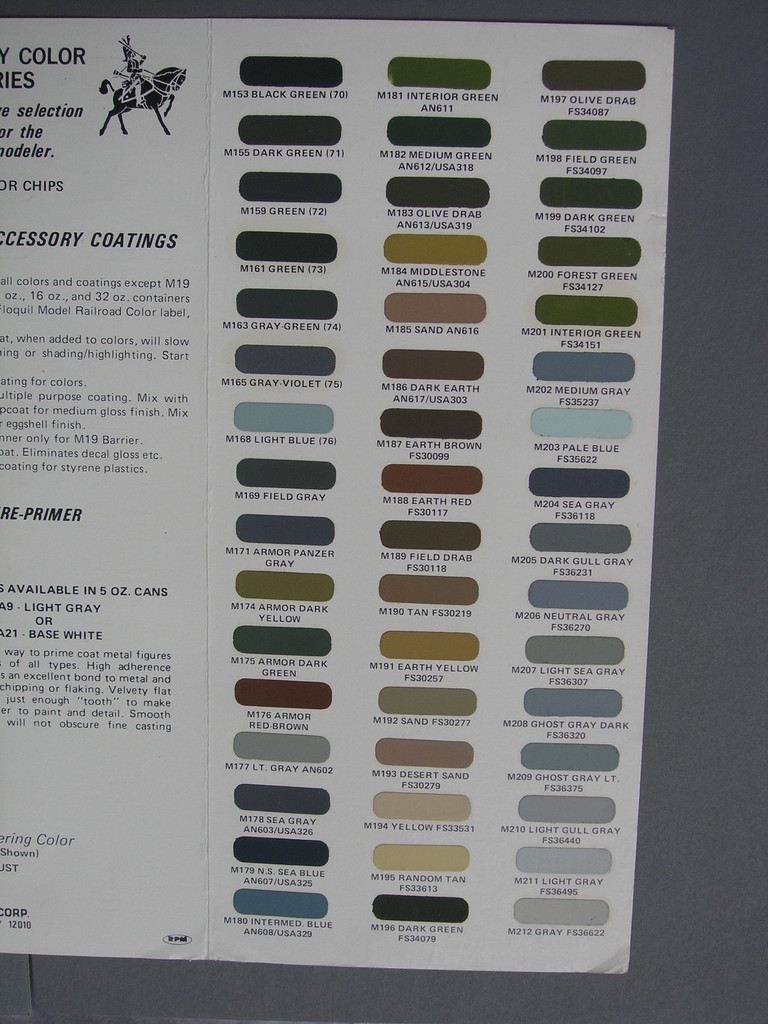
These late 1970s military and railroad sheets colours are probably the complete palette for the target years. This is your pool.
One key avenue to follow is the ‘Painting Miniatures’ book, because invariably these come with a Floquil colour chip card. Crucially, these can be dated by virtue of which reprinted edition you are holding. Logic would dictate that the card that goes with the book should tell you what the paint looked like when the book was printed. While these cards are useful, unfortunately it is not as simple as that, although I would recommend acquiring a copy of the book for its own sake. My newest copy is from 1993, which was the 38th edition. Others may have come after. Most of my copies are from the 70s. For the eagle-eyed among you, the 24th edition was September 1975. I don’t know why it gets left out of the publication list most of the time.
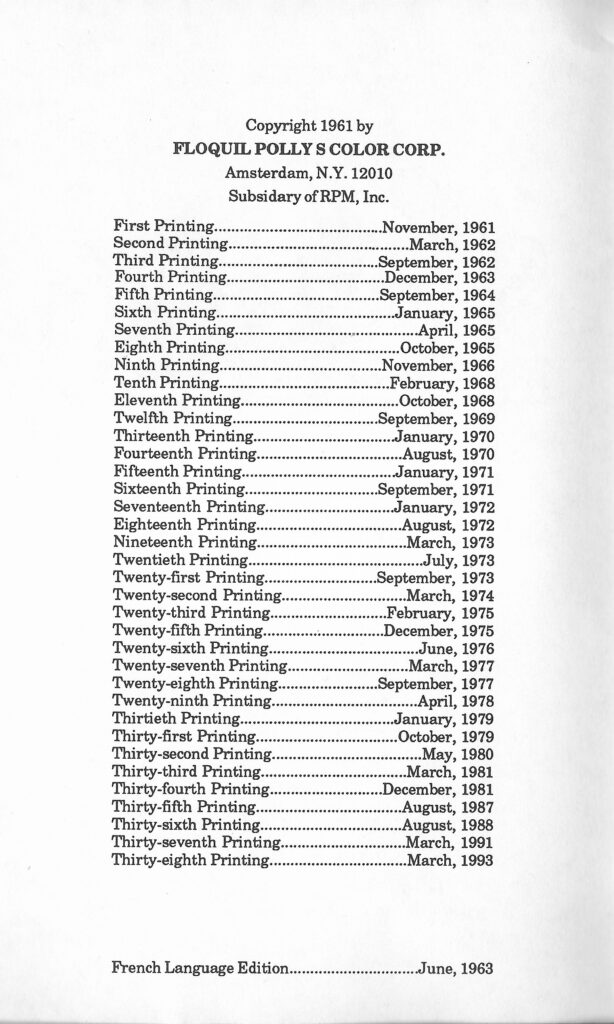
As part of my research, I have about 15 copies of the book, various other samples and chip cards, old catalogue material, old mixing charts, and other miscellaneous material published by Floquil Polly-S. Each piece of written material that was acquired expanded my knowledge in some way, even if that was only to narrow a timeframe, or to discount some possibility. In some cases the advance was small, but in other cases the piece of the puzzle solved was significant.
Sometimes a paint on the chip card appears the same on a mid-60s cards as it does on a late 70s cards, even though the cards refer to RR and R respectively. Sadly, while the colour on the card appears the same, the name is the same, and the designation number is the same [except for RR or R], the colour that comes out of the bottles can be very different. There’s another issue; anecdotal evidence from old time model train enthusiasts tells me that that the paints could also be inconsistent within batches.
You’re on slightly firmer ground with the military colours because the older military colours were all prefixed with a single M. Broadly speaking, those seem to come in during the early 70s and last until the changes made in the early 80s that brought the 11 railroad paints. The later military paints then had a 300 prefix, although the consistency in colours in the military line appears to survive well from M to 300. The 303 prefix military colours are from the 90s, and the colour list is mostly different, although some colours appear to have survived and maintained the correct hue.
Despite all of this, thankfully, many of the colours do maintain the correct hue across the generations, and the formula changes, which gives some leeway, but knowing exactly what was in the paint rack in the late 70s is going to be impossible. My best guess would be for either RR or R paints versus the even older ones. Within that, the R paints are probably more likely to have been the ones available in store, but I cannot discount that there were older ones still in circulation [or left about in the workshop from earlier projects]. The truth is that you’re going to have to try to buy a lot of old paint and reading material!
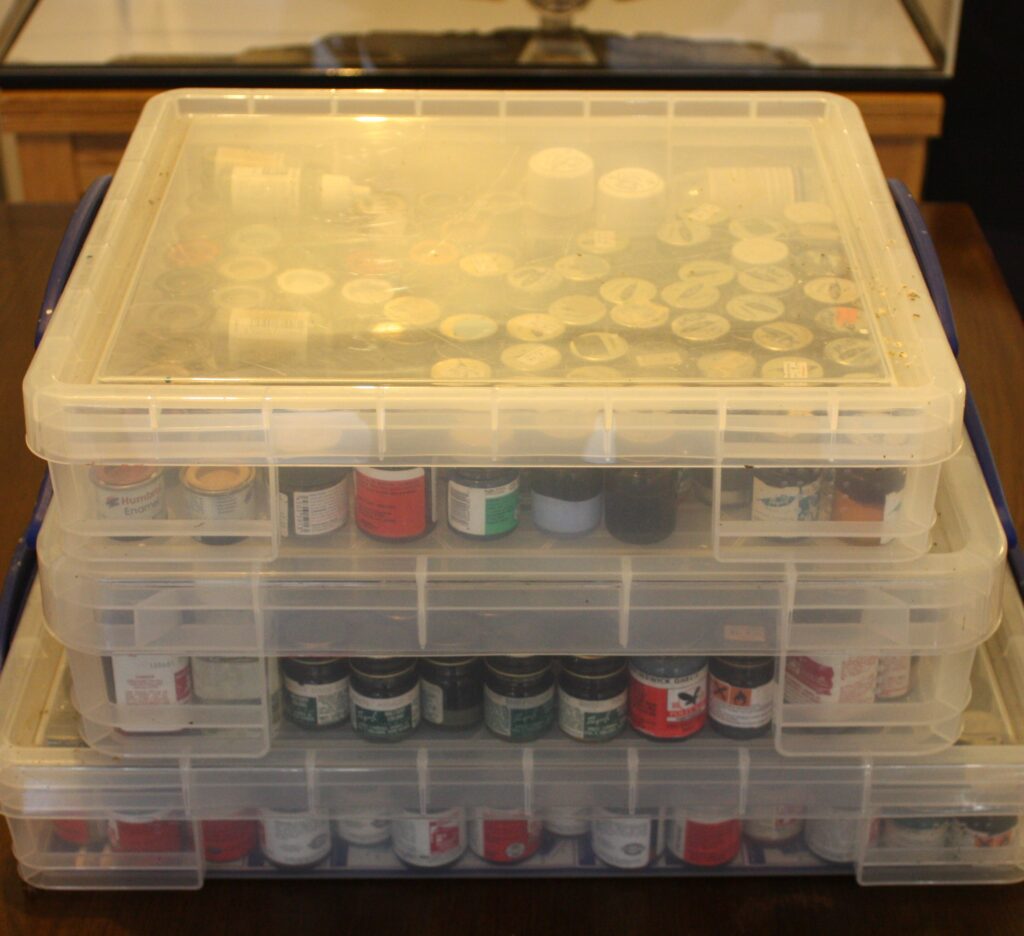
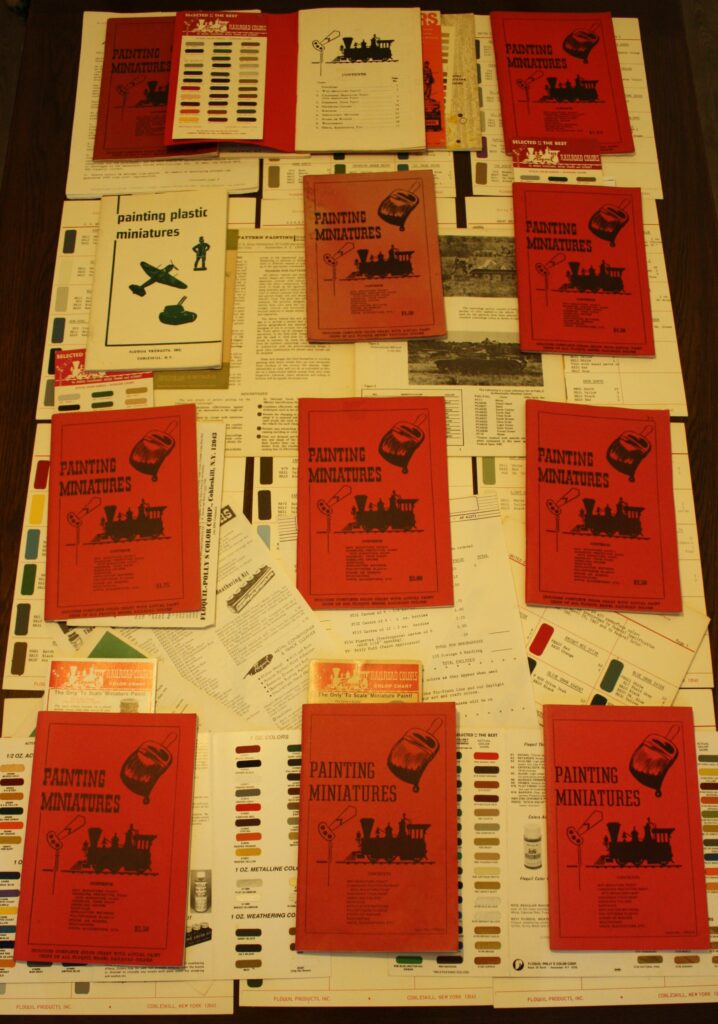
The Rogue Studios List
Lee Malone started publishing his list in the early 2000s, and he last updated it in 2008. If you’re not familiar with the Rogue Studios list, then hand your pass in at reception!
When I first started looking at Malone’s list, I knew a lot less about these paints than I do now, although I am still not sure how much I really know today. I’m fairly obsessed with Floquil, but I know other Fettheads who’ve probably forgotten more about these paints than I will ever know.
Malone’s list has long been published at The Dented Helmet. You can find it in a sticky thread at the top of the helmet section called ‘Boba Fett Helmet Consolidated Paint Up Threads’. This list evolved and was the basis of Malone’s paint master on the Master Replicas Prototype helmets he was asked to paint. In his thread he wrote “All colors are Floquil or Polly Scale paints it really doesn’t matter which you purchase as long as the color is the same they are the same paints for the most part”. Again, despite all that I have written above, Malone is correct about many of these colours working interchangeably, even in the Polly Scale lines. In a perfect world, we’d know exactly what was in the rack, which naming prefix, and from which exact batch, but that is never going to happen.
If you can see what a colour looks like in the bottle then you should generally not pay too much attention, because what it looks like in the bottle can be very misleading.
When considering the first colour, the main green, I have attempted to show the evolution through trying to research a single colour. My research, in earnest, started 2013, and I finally obtained the colour I was really looking for in early 2021.
“Helmet (Empire version)
* German Field Gray or Panzer Olive Green (Cheeks and dome) court is out on this one but GFG is a very old Floquil and was produced back in the day but not now so you’ll have to buy it from Tamiya”
This is the green colour for the main dome and cheeks. Obviously, this is an important colour because of its prominence on the helmet. You will often hear Panzer Olive Green referred to as POG. Testors did a version of this colour in the Model Masters Line that was called Panzer OlivGrun 1943, which I think is what Malone was referring to. MM did this in both acrylic and in enamel. For a straight out of the bottle match, this is a great base colour to start with, and is within a whisker of where you want to be. Sadly, as MM is now no more, this is no longer the great off the shelf option that it once was, because you’re still looking for a discontinued paint. Shame.
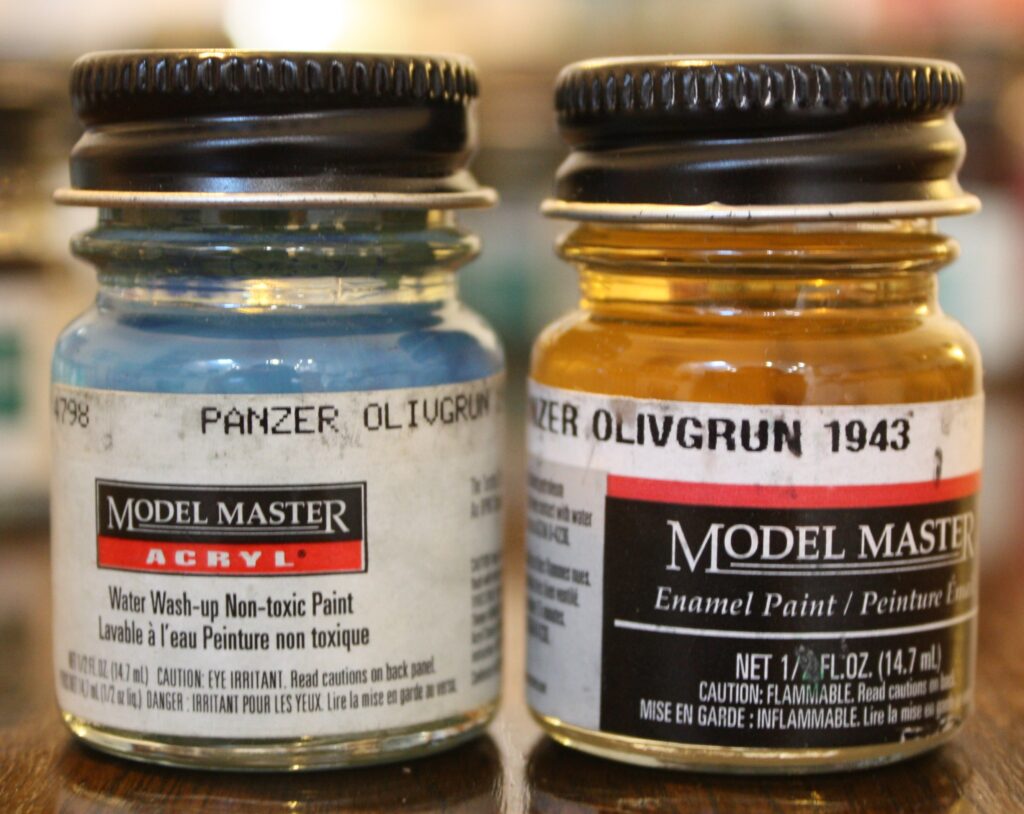
However, Pollyscale also did this colour, which they called Panzer Olive Green, and that I acquired after the MM. As you will see, the bottle in my picture has the Testors branding just visible on it. My feeling is that this bottle was probably produced in the 2000s. This is also a nice colour, although I prefer the MM POG as it comes straight out of the bottle. I feel this colour has a brown tint to it that I find slightly too much.
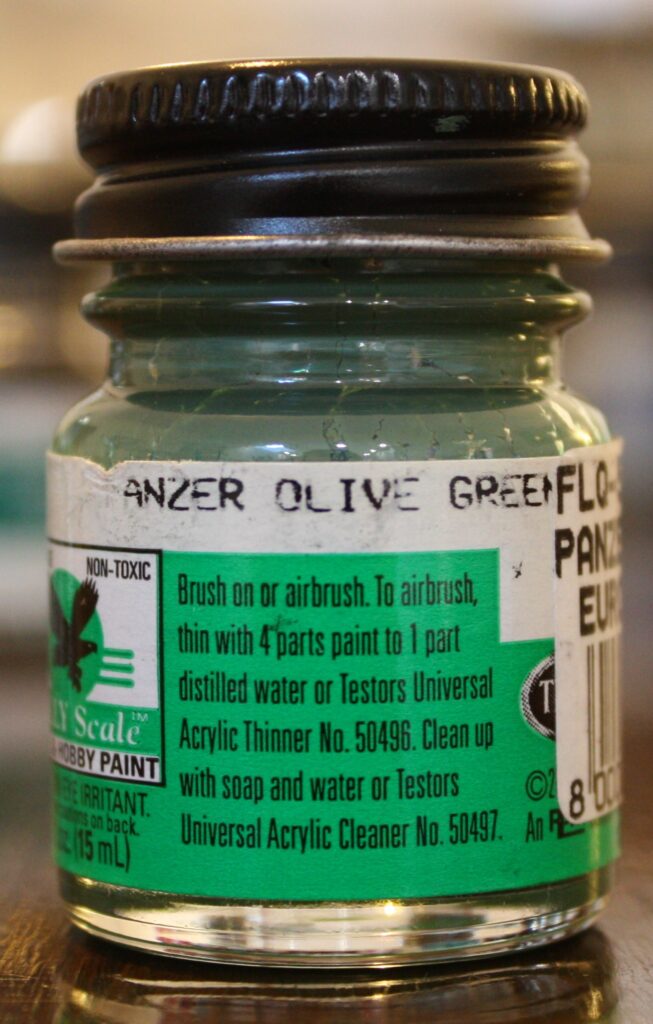
Not content, I then learned that Floquil did once make a colour called Panzer Olive Green, which I then set about pursuing. You will see from the picture that this is a 303 colour, which means it was not a period colour, although I was unaware of the 303/300/M distinction when I acquired it. Anyway, it’s not the right colour.
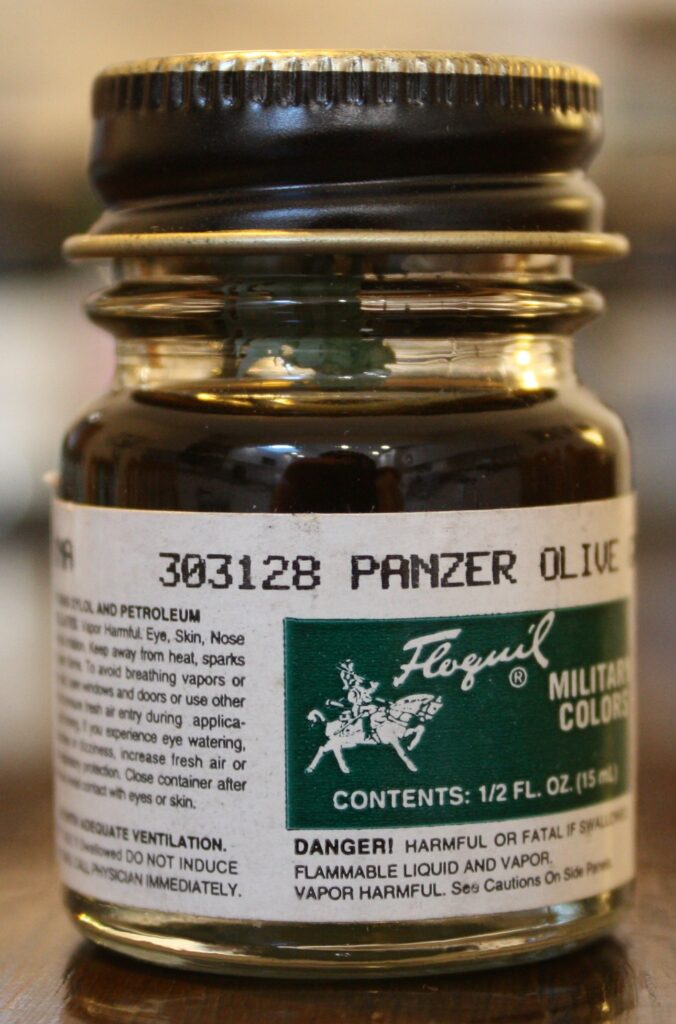
Then, when I was about to give up, I found it; ‘Floquil German Field Gray’. Actual Floquil German Field Gray, which is exactly what the Malone list told me I should be looking for: I’d nailed it!
As you’re Fett fans, you will likely understand how pleased I was that I had finally found what I was looking for in a rare old found part.
I waited with trepidation for it to arrive, only to be crushed by the disappointment of its arrival. Even in the bottle, I could see that it was totally the wrong colour. Bear in mind that I still did not know about the changes in formula at this time [you will see it is the later 303 line in the picture]. I didn’t understand what I’d done wrong – Malone’s post had spoon fed me the right colour, given me the name, told me that it was a very old colour that was no longer produced, and what I had matched those parameters, or so I thought. I thought wrong. A friend informed me of my error, and what it was. I can share my error now because others have published the information anyway, although you might have missed it, and because in the intervening years [several of them in fact] I acquired all the pieces that would have led me to the correct colour by myself.
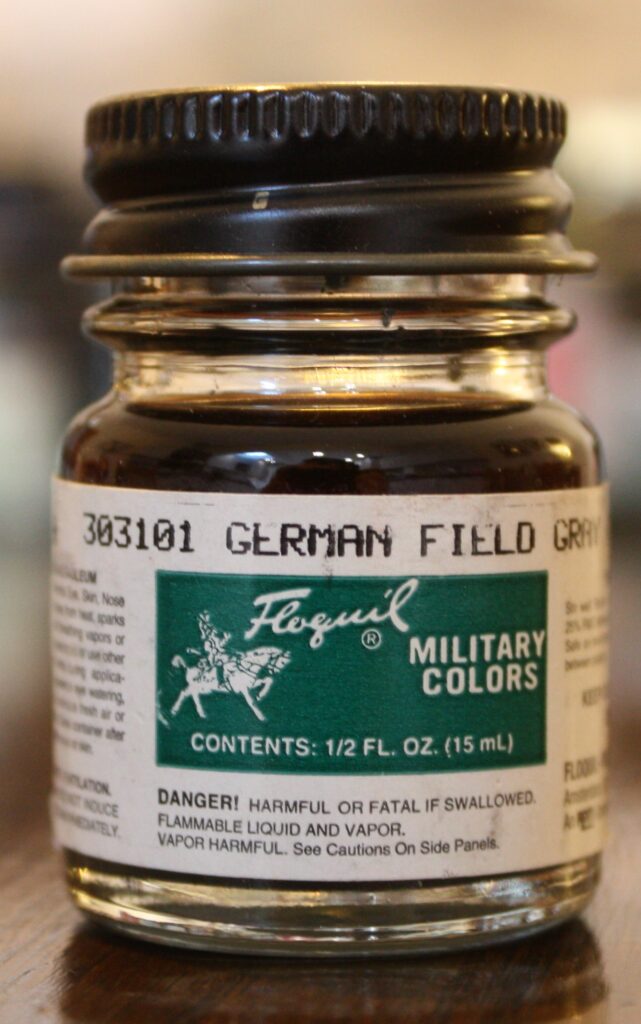
A few years ago, I acquired a copy of some Floquil mixing charts that gave formulas to reproduce nonstandard Floquil military colours by using existing Floquil RR and/or M paints. I bought them solely on the hunch that there might be something in there of interest to me. What I was hoping for was not in there, however; it was not a total loss for a few reasons. I was later to realise that the mixing charts contained chip matches to other colours of interest, and how to mix them, but the sheets also came with accompanying documents that told things of note. Of interest was a piece of paper, which is a Floquil military paint list dated to 1971.
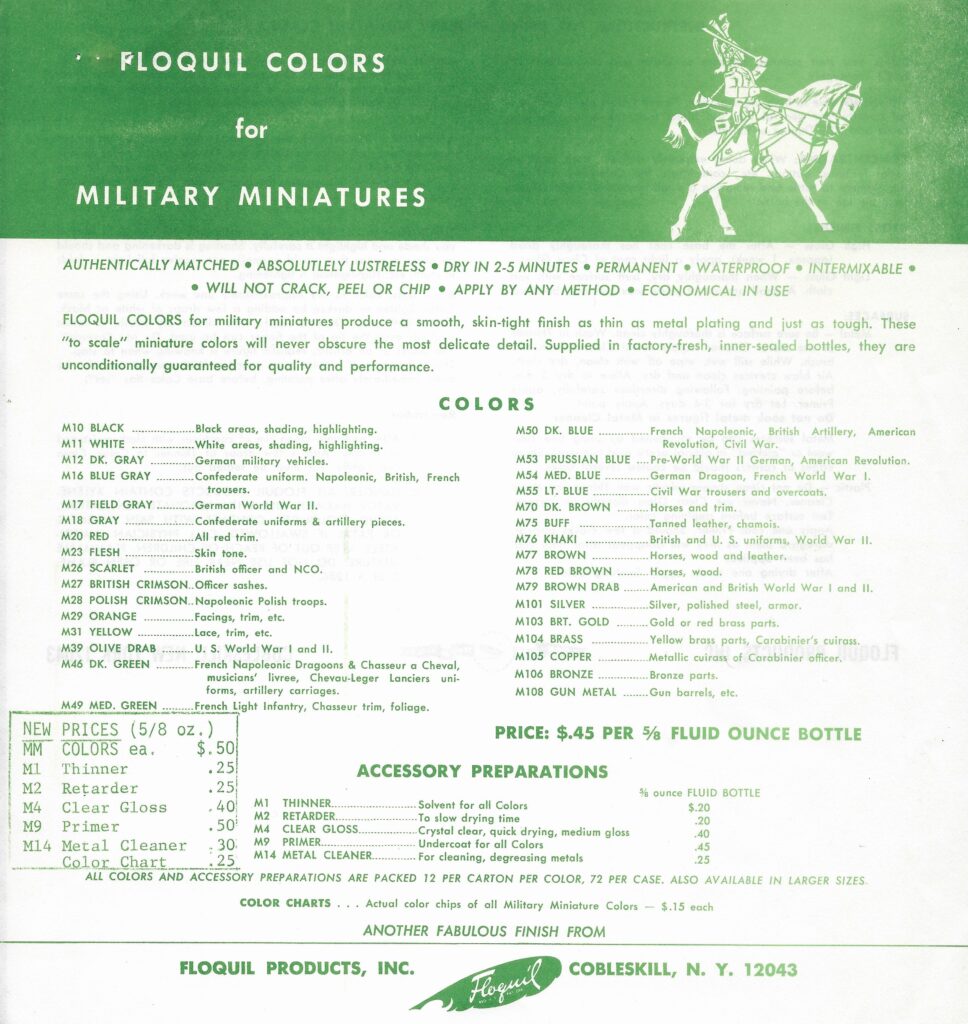
Look halfway down the left-hand side: “M17 FIELD GRAY……. German World War II”. That’s it. ‘German Field Gray’ per Malone’s list. I Had taken his list a little too literally. His list was correct, he had given us all the information, but my interpretation had been incorrect, and I had not realised my error because the ‘Painting Miniatures’ book, and the associated Colour charts, listed the M17 colour but omitted the word ‘German’. So, that’s it; the colour in his list is M17.
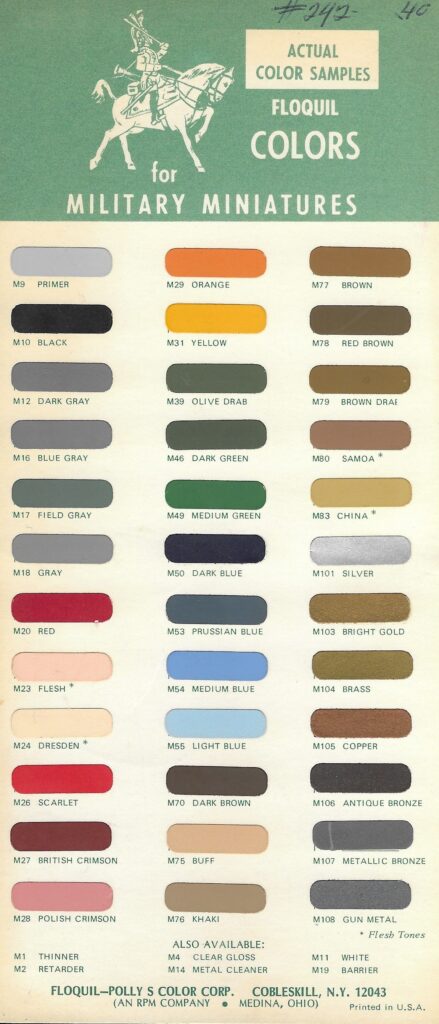
It still took me another handful of years to get the stuff in hand, even then; I had to buy a load of other colours that I wasn’t that interested in. It took me the best part of ten years to get that one colour over the line.
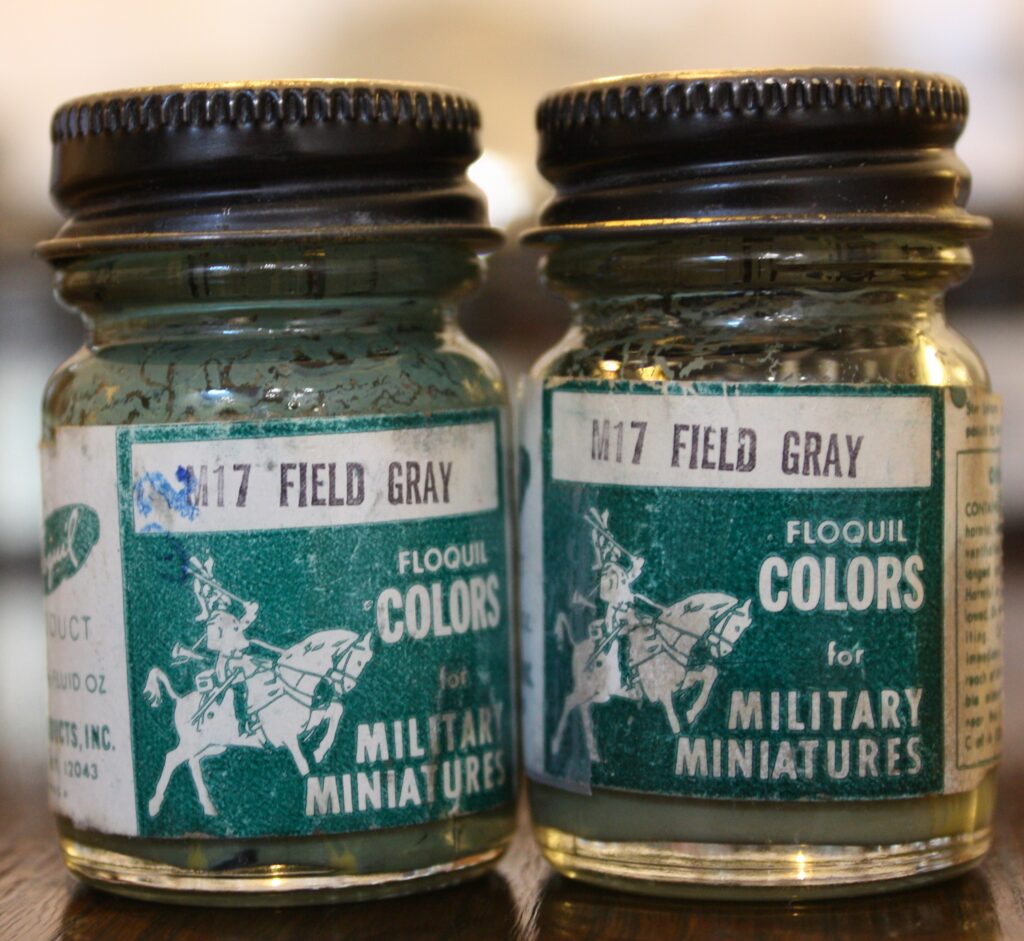
The Tamiya in Lee Malone’s list is the TS-78 in the aerosol can. The XF colour in the bottle is not the one you want for the ESB helmet. TS-78 is quite good for a straight out of the can colour and probably preferable to any of the POGs. It’s still available.
“* Caboose (not caboose red) (mandibles)”
This is Floquil DH10 Caboose (Delaware and Hudson). The later iterations of this Floquil colour were numbered 110088. This colour seems to become browner over time, so the 11 series appears browner than the earlier ones. Other options here might be Boxcar Red, or maybe Rock Island Maroon, but I still like older DH10. I’ve a suspicion that this colour may have been laid down over a far more vibrant red e.g., RR20 Caboose Red, or RR65 Signal Red, because we can see the brighter red showing through on the left mandible, and the ESB casts enable us to see that layer is under the darker red. This would have changed how the DH10 would appear when layered over it.
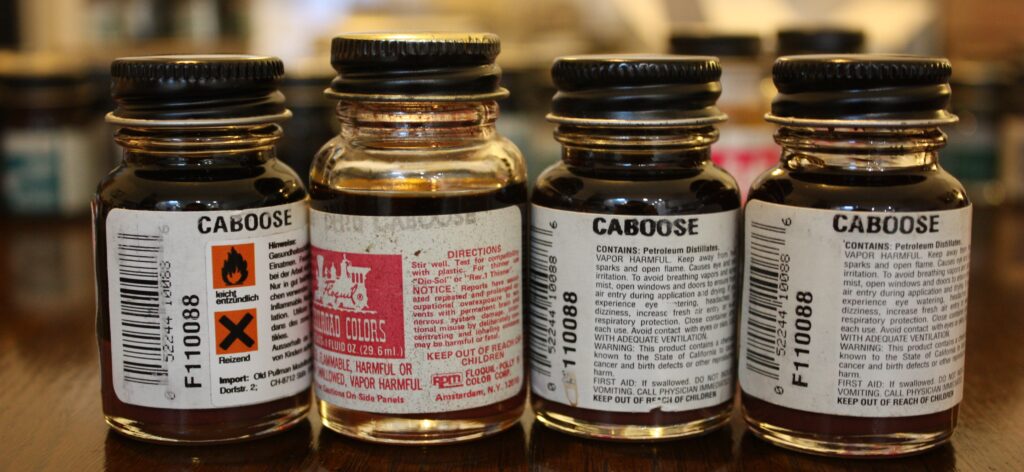
“* Reefer Yellow Vertical stripes (update) also the look of this strictly dependent on heavily applied it is and don’t apply heavily on frontal stripes”
There are a handful of period Floquil yellows available for this, but this is probably the best call for this. It’s RR31/R31 – Reefer Yellow. There are several modern colours that you might substitute for this, including by Humbrol.
“* Reefer Gray update (Gray around scratches)”
Reefer Gray is a colour that darkened significantly over the years and the period Floquil was actually quite light, which means that [I think] period Reefer Gray is less likely, but Malone may have been matching to a later available palette. Reefer Gray is RR12/R12.
I think that SP Lark Dark Gray (Southern Pacific) is a better bet, which is RR132/R132.
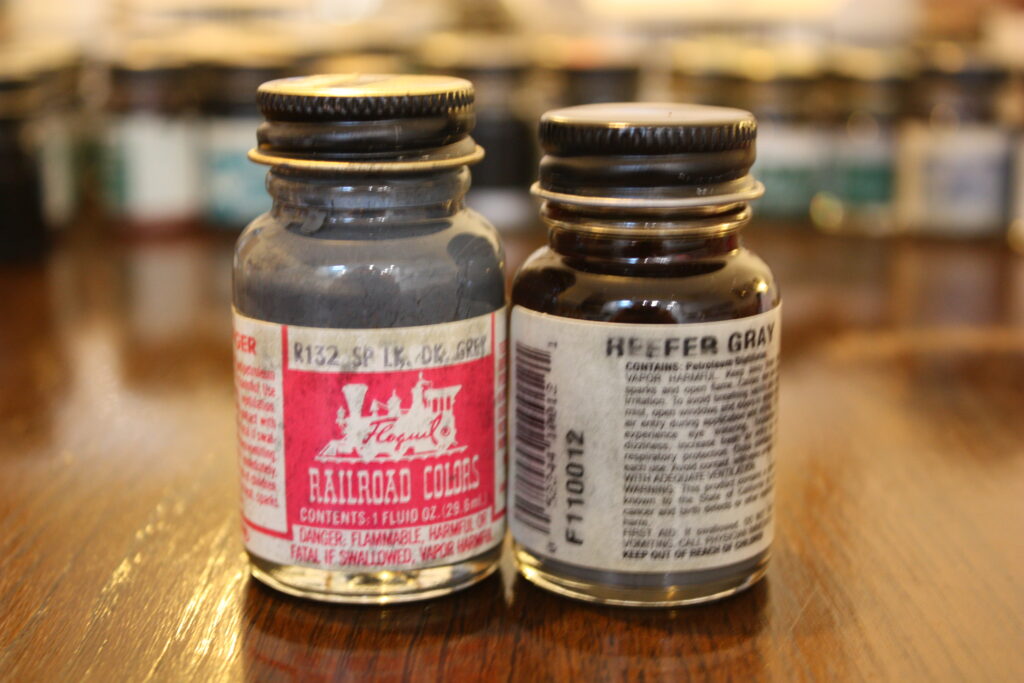
“* Rust (various locations)”
This is Rust RR73/R73. It was 110073 in the later version. This is for various splattering over the helmet. You might consider other colours for these splatters as well.
“* Chrome (scratches) I think this was actually a color called bright silver but this works best.“
Floquil did three period silvery colours, to the best of my knowledge. They were ‘Bright Silver’, per Lee’s list, ‘Old Silver’, and ‘Platinum Mist’ (RR101/R101, RR100/R100, and RR144/R144 respectively). One thing I will say about these Floquil silvers is that they really pop in way that some other paints do not. I found Humbrol Silver – 11 to be particularly drab and disappointing.
“* Main color back of helmet- RLM73”
Another colour from the Floquil Military line. It does not seem to have changed much from the old Xylene/Toulene formula even into the later 303 prefixed military colours. It’s M161, 300161, or 303261. RLM73 is fairly widely represented in many other paint lines. Vallejo do some nice ones, but there are plenty of others. RLM is Reichsluftfahrtministerium.
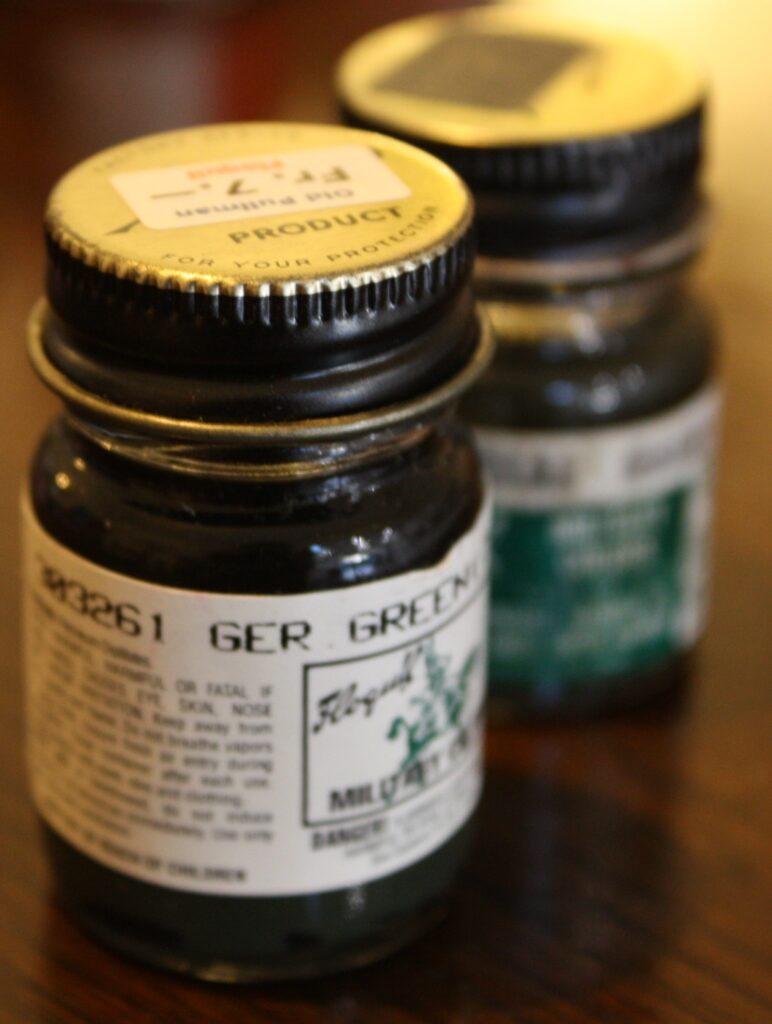
“* Back of helmet scratches- Concrete“
I have several generations of Floquil versions of this paint, RR82/R82, and the later 110082. It seems to remain fairly constant across the generations. It might be better to say that it’s consistent enough that you’re unlikely to notice the shift given its place in the colour scheme of the back panels.
“* Earth Enamel(Rangefinder ear) I hate this paint.”
‘Earth’ and ‘Foundation’ appear to have crossed paths over the years to the point where either might fit depending on which generation you are looking at. Personally, I prefer ‘Foundation’ for this, which is RR84/R84, but Earth is RR81/R81. Earth seems to lighten over time, so if you have 110081 then you’re probably going to be alright.
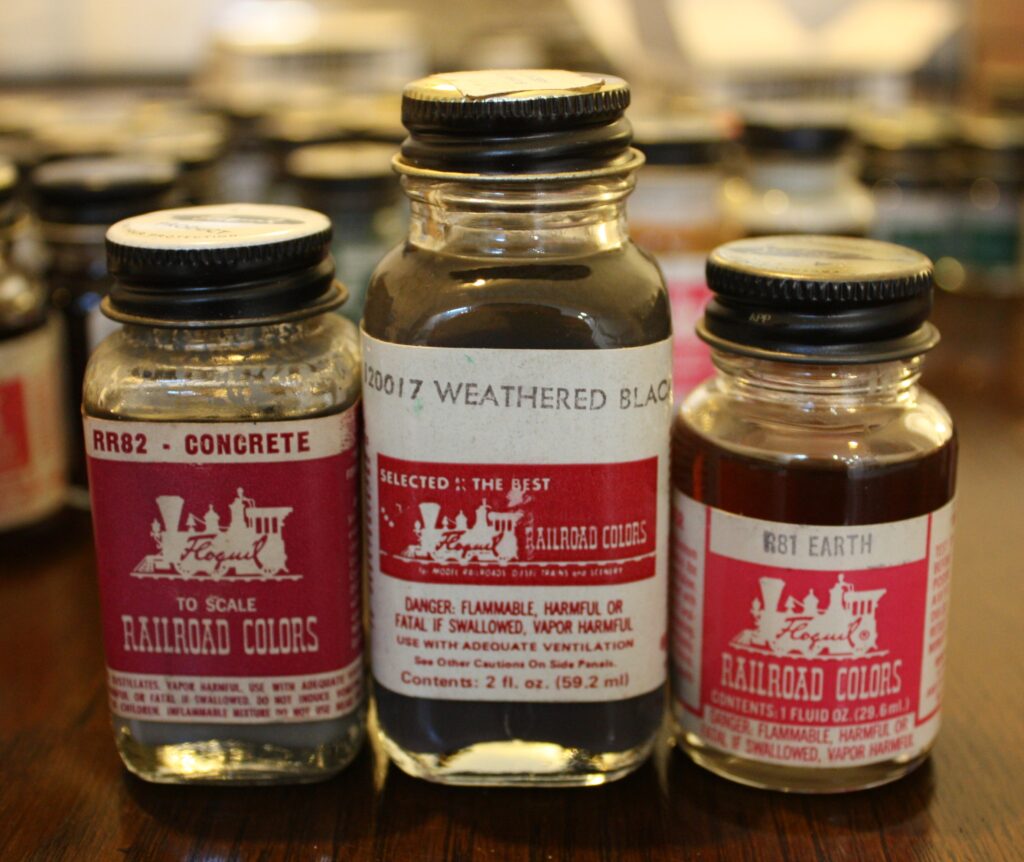
“* POG Green Update!(Left ear)”
This would make the left ear the same colour as the dome, which I do not think is right. There is a vintage military colour that is perfect for this, so get out those old lists – shush, it’s a secret.
“* PRR Green (I like weathered black better) (Inside cheeks) this is practically black.“
PRR Green is ‘Pennysylvania Railroad Green’. This is the name of the later Pollyscale iteration of the colour. The earlier colour naming was simply ‘Brunswick Green’, which was RR34/R34. Lee M is correct in that this is virtually black. When he says, “I like weathered black better”, I had always worked on the assumption that he meant that he preferred to use a black and then weather rather than that he was referring to Floquil ‘Weathered Black’, which is a separate colour.
“* Caboose (Red scratches on left ear). “
This is actual ‘Caboose Red’, which is far brighter than Caboose/DH10 Caboose for the mandibles. That was RR20/R20. The other period bright red could be ‘Signal Red’. Again, there may be some others, but those would be my choices.
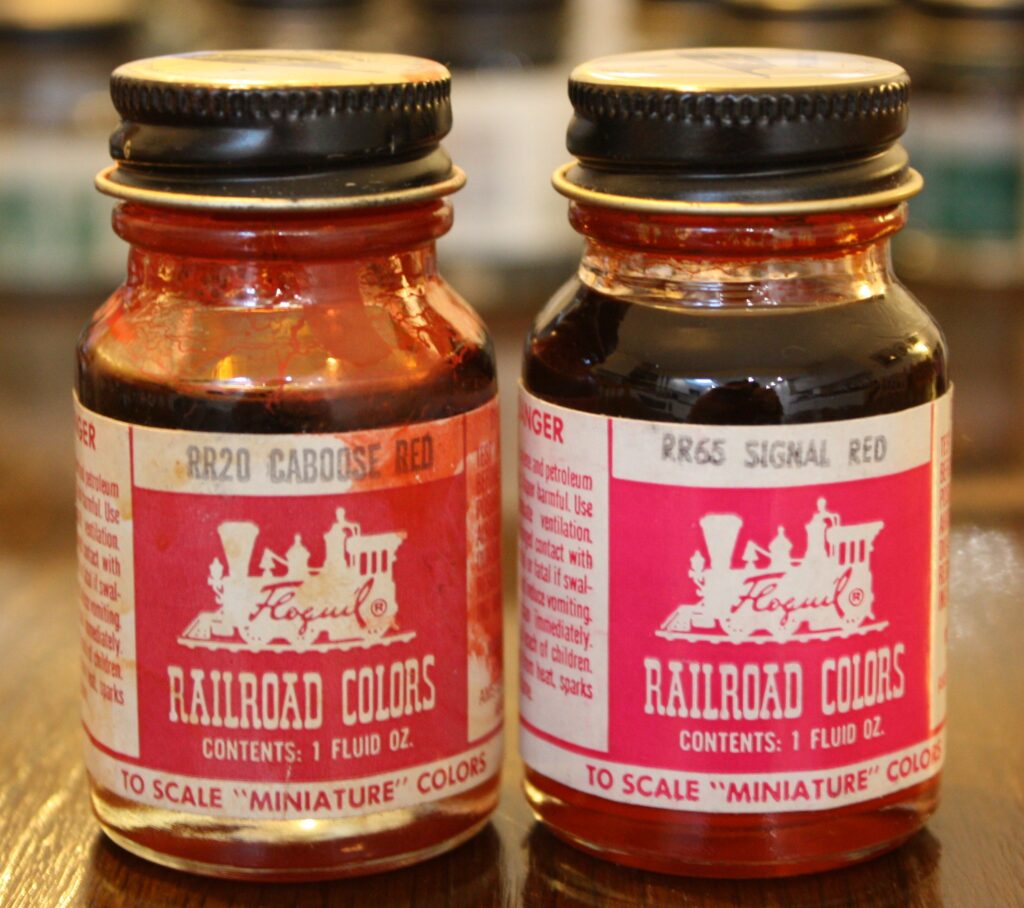
“* Light Gray (on left ear) any light gray will do.”
I chose Floquil Primer for this. That is RR9/R9. It has a lovely, slightly blue-grey tinge that I think is perfect. In fact, I think that R9 primer should be considered as the correct light grey for all over the helmet. When I saw pictures of the ESB with the RF ear removed, which showed a nice big slab of this light grey in one patch, I felt confident that this was the right colour.
“* PRR Maroon for the dark color on mands may need to darken this color with a touch of black. I know the original color but Floquil hasn’t made the color for almost 20 years so it’s very very hard to find and this will do trust me.”
PRR Maroon (again, Pennysylvania Railroad) is a Pollyscale Colour, although there may be a Floquil I have not encountered. If there is, then I have never seen it referred to in any published material. I believe that what is on the table here is Floquil RR64/R64 ‘Maroon’.
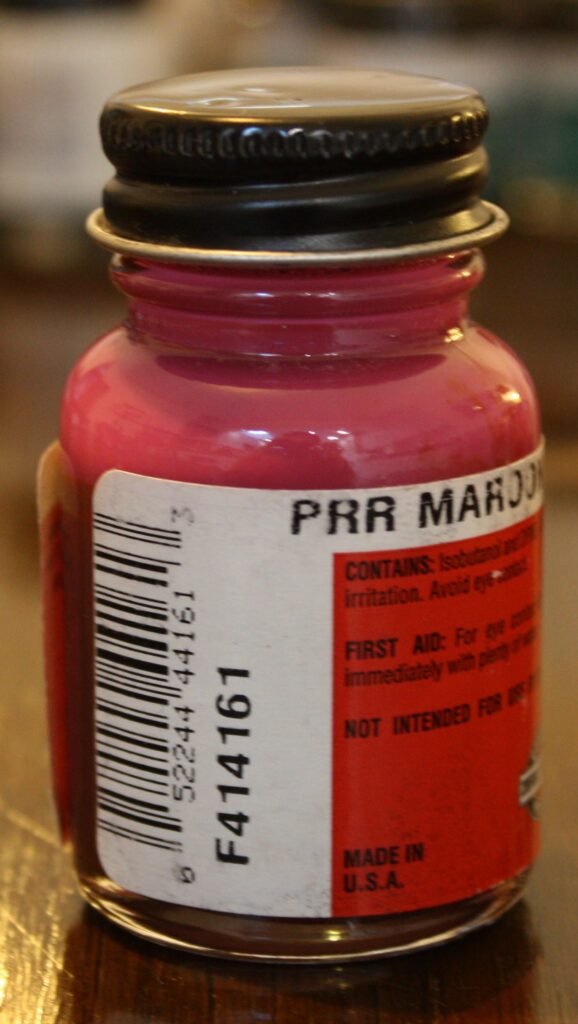
This is a bit of a weird one. The Floquil colour chips that I possess, and I possess quite a few, represent that the colour does not seem to change much across the years, however; the actual bottles of paint I possess tend to vary significantly. The R64 seems very purple. The earlier RR64s, while still inconsistent, seem a much redder shade of purple/Claret. I think it is possible that the colour may have been mixed with another colour prior to being sprayed, although I tend to think this might have been by virtue of not cleaning the airbrush rather than a deliberate attempt at mixing.
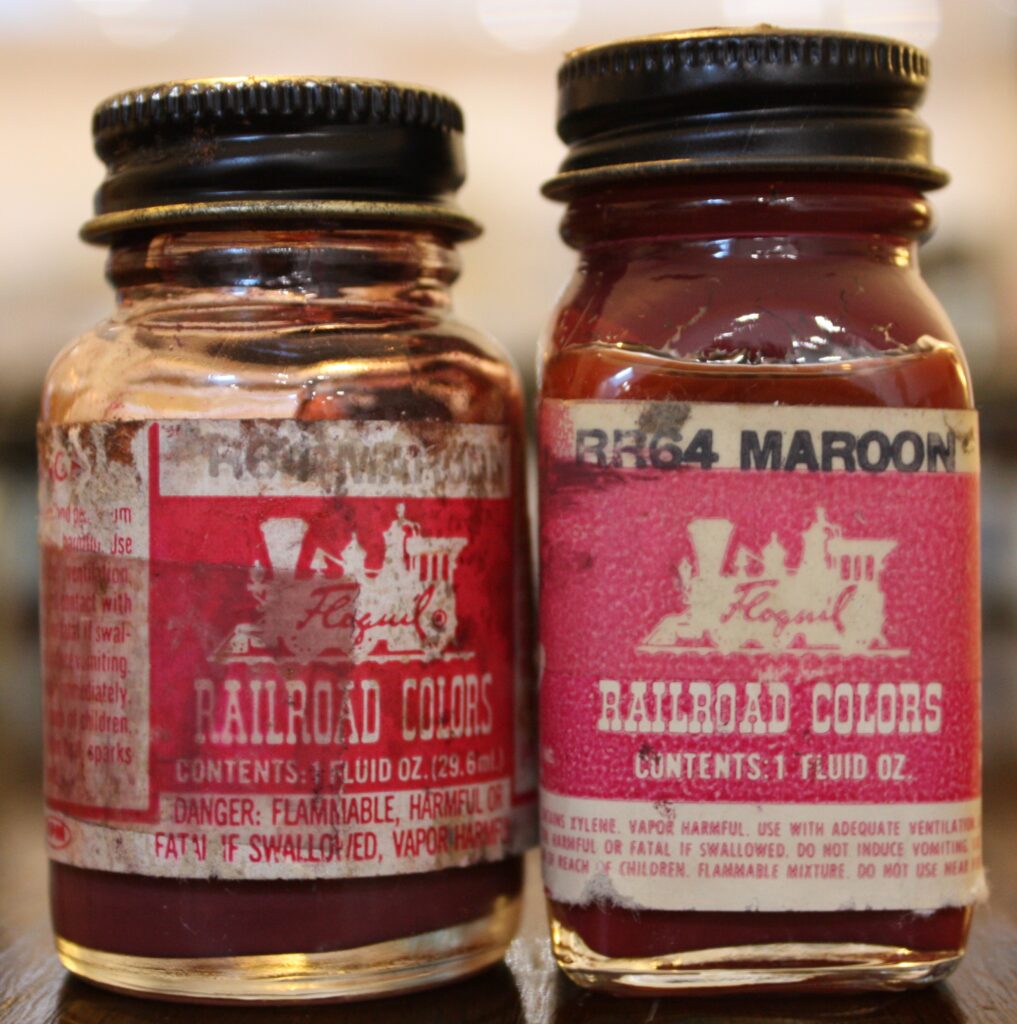
So, here is the problem with these old paints as best typified. The Top colour is RR64 – Maroon. The bottom colour is R64 – Maroon. According to the naming conventions, they are supposed to be the same colour. According to different generations of the Chip Cards, they should look exactly the same. Clearly, they are not exactly the same. This type of thing can be seen across lots of colours to varying degrees.
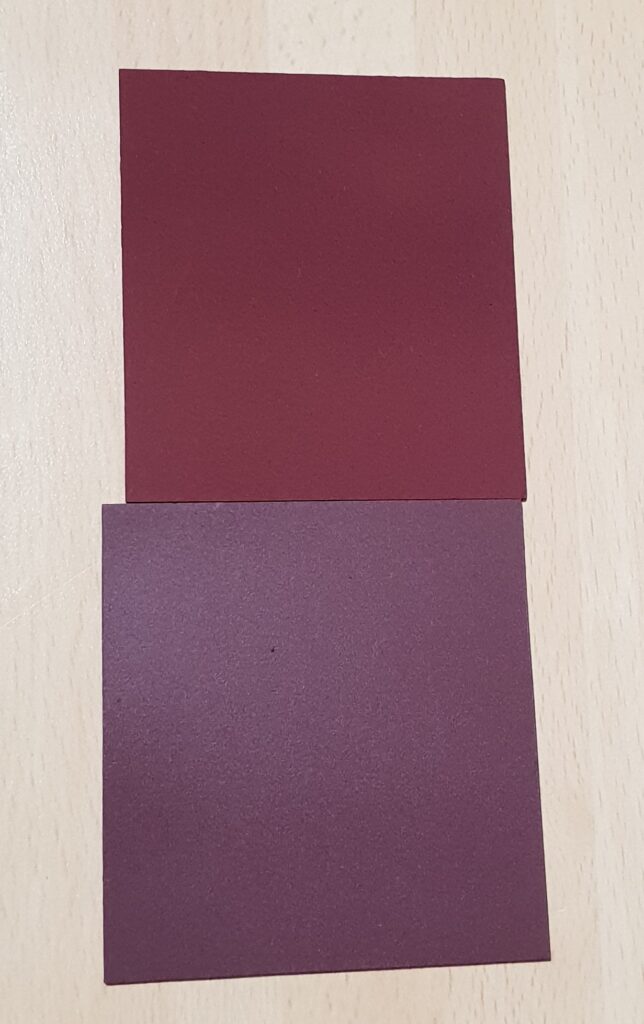
One last thing on the Maroon – Malone is correct; PRR Maroon with a touch of black is pretty awesome. Assuming you can still get it that is.
So there you have it. That’s what goes into a hobby within a hobby. Was it worth it? Who can say, but it has certainly been a fun distraction for the last decade. Finally, some of these old paints spray like a dream. Some of them spray like shit. It’s the luck of the draw. In many cases it was easier to create my own chips and then match them. It isn’t that expensive, nor difficult, and it generally gives a better paint to work with.
Live the dream.

